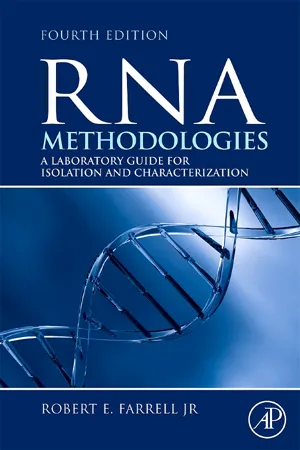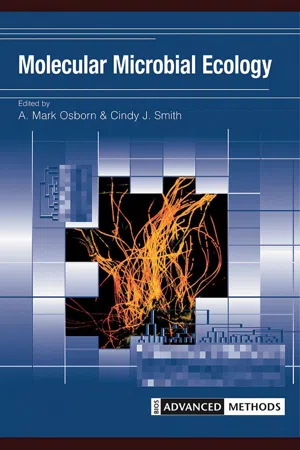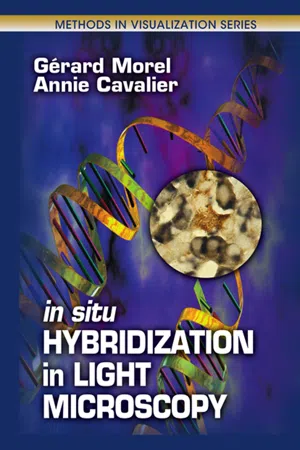Biological Sciences
DNA Hybridisation
DNA hybridization is a process where single-stranded DNA molecules from different sources are allowed to form double-stranded molecules by base-pairing. This technique is used to identify similarities and differences in DNA sequences between different organisms, and to study gene expression and genetic relatedness. It is a fundamental tool in molecular biology and genetics research.
Written by Perlego with AI-assistance
Related key terms
1 of 5
5 Key excerpts on "DNA Hybridisation"
- eBook - ePub
RNA Methodologies
Laboratory Guide for Isolation and Characterization
- Robert E. Farrell Jr., Robert E. Farrell, Jr.(Authors)
- 2009(Publication Date)
- Academic Press(Publisher)
Chapter 13. Practical Nucleic Acid HybridizationRationale
Perhaps the most complex, yet least understood component of molecular biology studies are the parameters that govern nucleic acid hybridization, a process first described by Marmur and Doty (1961) . At the heart of molecular hybridization, two complementary polynucleotide molecules hybridize in an antiparallel fashion to form a double-stranded molecule. This phenomenon is also known as base-pairing, duplex formation, annealing, and renaturation.These days, most investigators are familiar with the concept of hybridization in the context of the polymerase chain reaction, and all of its variants, in which complementary nucleic acid molecules are repeatedly coaxed to hybridize and then denature for the purpose of amplification. Thus, a profound understanding of the thermodynamic behavior of the specific molecules involved (the primers and the template) is necessary to design a temperature cycling profile that will support high fidelity amplification. Moreover, one must understand that hybridization kinetics are influenced by other components of the reaction, and these variables are discussed here.In the context of traditional blot analysis, and under conditions that promote nucleic acid hybridization, the strands that participate in duplex formation are known by specific names. The probe strand, as the name implies, usually carries some type of label that permits localization and quantitation of the probe at the conclusion of the hybridization period. The other strand, commonly known as the target, either may be immobilized on a solid support for filter-based analysis (e.g., Northern analysis) or may simply be suspended in buffer, free to participate in solution hybridization (e.g., S1 nuclease analysis).For example: the objective of a study might be the assessment of c-myc transcription in cells acquired by biopsy. Because the sample contains thousands of different mRNA species, addressing this question would require a suitable complementary probe, that is, one that would be able to hybridize only to c-myc transcripts. The probe itself could be a cDNA sequence, a genomic sequence, an antisense RNA sequence, or an oligonucleotide. The c-myc-specific probe might be labeled with 32 P, for detection by autoradiography; alternatively the probe could be hapten-labeled or prepared by direct enzyme labeling, using any of the techniques described in Chapter 12 that support detection by chemiluminescence. Assuming that the hybridization stringency is satisfactory, c-myc probe molecules will only hybridize to complementary c-myc transcripts, which are the target molecules for that particular probe. When performed properly, the probe is always present in a large molar excess so as to ensure that all c-myc - eBook - ePub
- Mark Osborn, Cindy Smith, Mark Osborn, Cindy Smith(Authors)
- 2004(Publication Date)
- Taylor & Francis(Publisher)
8 Applications of nucleic acid hybridization in microbial ecology A.Mark Osborn, Vivien Prior and Konstantinos Damianakis 8.1 Introduction Nucleic acid hybridization can be defined as the complementary base pairing between two nucleotide strands mediated by Watson-Crick hydrogen bond formation between individual nucleotides. As such, hybridization is central to biology, and is responsible for genomic rearrangements via both homologous and site-specific recombination. Nucleic acid hybridization is also central to molecular biology, both in its direct application as a tool to detect specific DNA sequences (1), and also as an integral process during the polymerase chain reaction (PCR) and DNA sequencing during the hybridization (annealing) of oligonucleotide primers to complementary single-stranded DNA templates. In microbial ecology, as in all areas of biology, a tremendous assortment of nucleic acid hybridization methodologies has been developed, beginning with an initial emphasis on applying DNA probes to confirm the presence of particular genes in individual microorganisms and/or recombinant DNA constructs, then subsequently in the specific detection of particular organisms or genes within environmental samples, and also as a tool to estimate the complexity in terms of species diversity of microbial communities. One major application of nucleic acid hybridization has been the development of fluorescently in situ hybridization (FISH) to detect and enumerate specific microbial taxa within environmental systems, using oligonucleotide probes. This approach is of considerable importance for investigating spatial distribution of microbial communities, and is discussed at length in Chapter 9. This chapter will thus focus on in vitro applications of nucleic acid hybridization, defined here as those hybridization experiments that are conducted using nucleic acids isolated either from individual microorganisms, or directly from environmental samples - eBook - PDF
Modern Methods in Protein- and Nucleic Acid Research
Review Articles
- Harald Tschesche(Author)
- 2019(Publication Date)
- De Gruyter(Publisher)
It is expected that DNA probe assays will appear in routine clinical 38 laboratories in the next few years for diagnosis of cancer, genetic - and infectious diseases (6, 7, 8, 9). However, the use of DNA probes in routine assays is still at the beginning, because the requirements for a routine assay differs strikingly from that of a research technique. At the moment DNA probe assays are cumbersome, timeconsuming and not simple enough for routine laboratories. Therefore, DNA diagnostics will further progress by the development and application of faster, simpler, and non-radioactive techniques for the detection of specific nucleic acid sequences (10, 11, 12). The purpose of this chapter is first, to review basic principles of DNA hybridization then, to present different applications of DNA diagnostics and finally, to introduce several new methodologies which improve and simplify the current hybridization technology. Basic Principles of DNA Hybridization The DNA molecule normally is built up by two nucleotide chains held together by hydrogen bonds between complementary base pairs. At raised temperature these duplex strands of the DNA molecule dissociate into single strands. Under appropriate conditions the separated nucleic acid strands will reassociate to stable duplexes (13). This reversible process of formation of base-paired DNA:DNA, DNA:RNA, or RNArRNA hybrids is called hybridization. In the basic hybridization assay a specificly labeled DNA fragment, called the DNA probe, hybridizes with its complementary sequence on the target nucleic acid, which has to be denatured into single strands before hybridization. After separation of the hybridized from the non-hybridized probe, the detection of the newly formed double strand reveals the presence of a specific nucleic acid in the sample. In conventional hybridization assays the DNA probes are modified chemically or enzymatically with radioactive isotopes (^H, 32p_ 125j ( 35s). - Walter Scott(Author)
- 2012(Publication Date)
- Academic Press(Publisher)
MOBILIZATION AND REASSEMBLY OF GENETIC INFORMATION THE FUSION OF DNA MOLECULES AND GENETIC RECOMBINATION Huntington Potter and David Dressier The Biological Laboratories, Harvard University, Cambridge, Massachusetts 02138 DNA recombination is among the cell's most significant activities. It is important both for the generation of individuals with new genotypes and for the maintenance of a constant communication between individuals, preventing over-rapid speciation and devolution. While numerous models have been proposed that can logically lead to the formation of recombinant chromosomes, the precise molecular mechanisms involved in the recombina-tion process remain a topic of current experimentation. A convenient place to begin a discussion of the molecu-lar mechanisms involved in recombination is with a suggestion made by Robin Holliday in 1964. Holliday 1 s essential contri-bution was to propose a mechanism for fusing two DNA molecules together so that they could ultimately undergo a reciprocal exchange of genetic information (1-3). The Prototype Holliday Model A prototype model that uses the Holliday recombination intermediate is shown in Figure 1. Two homologous double helices are aligned, and in each the positive strands (or, alternatively, the negative strands) are nicked open in a given region. The free ends thus created leave the comple-mentary strands to which they had been hydrogen-bonded and become associated instead with the complementary strands in the homologous double helix (Figure 1 A-KD). The result of this reciprocal strand invasion is to establish a tentative physical connection between the two DNA molecules. This linkage can be made stable through a process of DNA repair, which in this case can be as simple as the formation of two phosphodiester bonds by the enzyme ligase (Figure 1-E). The structure shown in Figure 1-E is the Holliday recombination intermediate. Although the intermediate is 93 Copyright © 1980 by Academic Press, Inc.- eBook - PDF
- Gerard Morel, Annie Cavalier(Authors)
- 2000(Publication Date)
- CRC Press(Publisher)
Hybridization 112 With this approach, it is possible to localize the nucleic acid being sought, and to determine the tissue and cell structures in which it is contained (Figure 4.2). ➫ The advantage of this approach is that it can be used to detect the presence of a particular nucleic acid among all the constituents of a cell. The opposite of hybridization is denaturation, which happens at melting point, and which con-sists in the separation of the two strands of the hybrid. ➫ Denaturation is generally carried out by raising the temperature. ➫ See Section 3.10 1 = Labeled probe. 2 = Target nucleic acid. 3 = Hybrid. Figure 4.2 Principle of hybridization. ❑ Nature of hybrids • Stable hybrids — Stable hybrids are charac-terized by the creation of all the hydrogen bonds involved in the formation of the new molecule (Figure 4.3). ➫ A perfect, very stable double strand is obtained. Figure 4.3 Stable hybrids. RNA probes give the most stable hybrids. ➫ In increasing order of stability: DNA – DNA < DNA – RNA < RNA – RNA ′ ′ ′ ′ ′ ′ ′ ′ 4.1 Principle of In Situ Hybridization 113 Hybrids that are very rich in G and C bases are much more stable than those that are rich in A and T/U bases. ➫ There are two hydrogen bonds between A and T ( see Figure 4.13), but three between G and C ( see Figure 4.14). • Unstable hybrids — Hybrids containing a lot of A and T/U bases are less stable, and thus eas-ier to denature (Figure 4.4). Figure 4.4 Unstable hybrids. If the hybridization temperature is a lot lower than the melting temperature (Tm), many hybrids are formed, some of which are unstable. ➫ See Section 4.2.3.1 (Determination of Tm). • Partial hybrids — With low levels of homol-ogy of sequences between the two molecules of nucleic acid, matching will not be total (Figure 4.5). ➫ These are mismatched hybrids, where only a certain number of hydrogen bonds are involved in the formation of the molecule (unstable hybrids). Figure 4.5 Partial hybrids.
Index pages curate the most relevant extracts from our library of academic textbooks. They’ve been created using an in-house natural language model (NLM), each adding context and meaning to key research topics.




